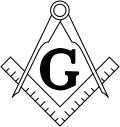| Part of a series on |
| Freemasonry |
|---|
 |
Hundreds of conspiracy theories about Freemasonry have been described since the late 18th century. [1] Usually, these theories fall into three distinct categories: political (usually involving allegations of control of government, particularly in the United States and the United Kingdom), religious (usually involving allegations of anti-Christian or Satanic beliefs or practices), and cultural (usually involving popular entertainment). Many conspiracy theories have connected the Freemasons (and the Knights Templar) with worship of the devil; [2] [3] these ideas are based on different interpretations of the doctrines of those organizations. [4]
Contents
- List of conspiracy theories associated with Freemasonry
- Political
- Religious
- Other
- Masonic conspiracy theories in mass culture
- See also
- Notes and references
- External links
Of the claims that Freemasonry exerts control over politics, perhaps the best-known example is the New World Order theory, but there are others. These mainly involve aspects and agencies of the United States government, but actual events outside the US (such as the Propaganda Due scandal in Italy) are often used to lend credence to claims.
Another set of theories has to do with Freemasonry and religion, particularly that Freemasonry deals with "the occult". [5] These theories have their beginnings in the Taxil hoax. [6] [7] In addition to these, there are various theories that focus on the embedding of symbols in otherwise ordinary items, such as street patterns, national seals, corporate logos, etc.
There are Masonic conspiracy theories dealing with every aspect of society. The majority of these theories are based on one or more of the following assumptions:
- That Freemasonry is its own religion, requires belief in a unique Masonic god, and that belief in this Masonic god is contrary to the teachings of various mainstream religions (although usually noted in terms of being specifically contrary to Christian belief) [8]
- That the 33rd degree of the Scottish Rite is more than an honorary degree, coupled with the belief that most Freemasons are unaware of hidden or secretive ruling bodies within their organization that govern them, conduct occult ritual, or control various positions of governmental power [9]
- That there is a centralized worldwide body that controls all Masonic Grand Lodges, and thus, all of Freemasonry worldwide acts in a unified manner

